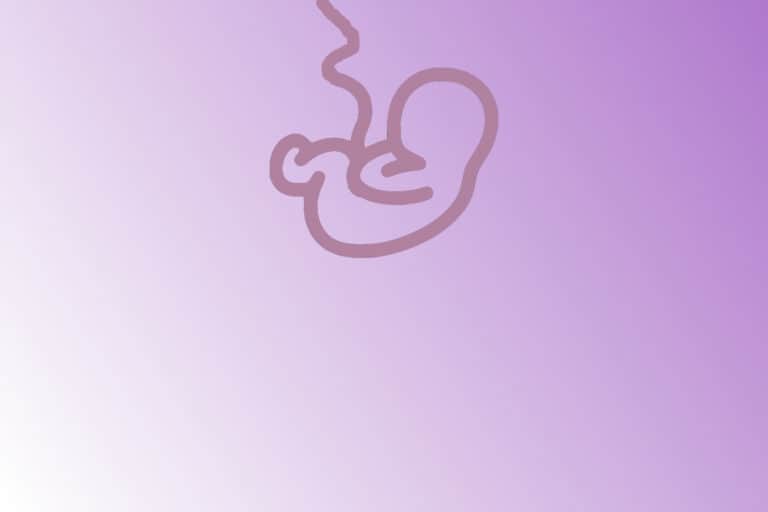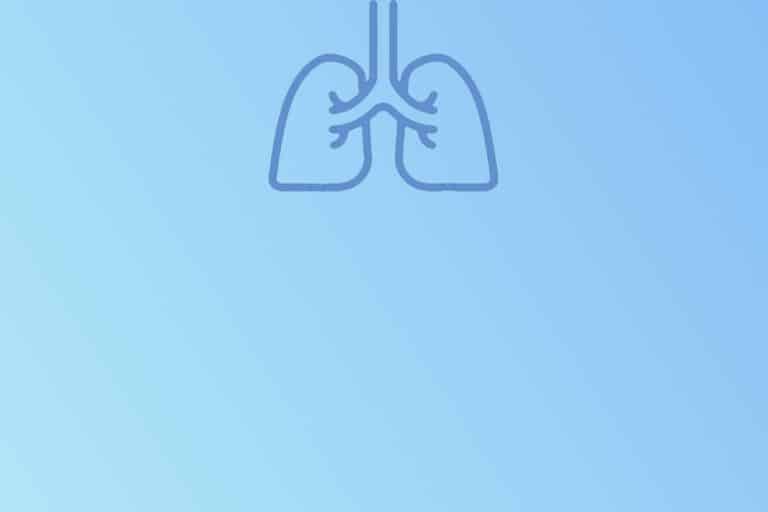Respiratory distress syndrome
Respiratory distress syndrome (RDS) describes any change to frequency and/or quality of breathing pattern in newborns. Breathing rate < 60/minute (can be up to 70/min during the first hours of life and sets to around 40/min) is considered physiologic and newborn should not display any signs of increased work of breathing (dyspnea).
Transition to extra-uterine life is very fast (within seconds to minutes) as a newborn cries, pinks up and then starts to have regular and calm breathing pattern. Successful postnatal adaptation depends mainly on 2 factors:
- Spontaneous breathing (water in lungs resorbed into blood/lymphatic vessels = gas exchange = increased pO₂ = pulmonary vasodilation = circulation changes see below)
- Circulation transformation (pulmonary blood flow increases as pulmonary hypertension subsides = ductal shunting changes to left-right + increased pO₂ causes ductus arteriosus to close)
Pulmonary causes
- hyaline membrane disease (sometimes used interchangeably with RDS, although RDS constitutes multiple origins of breathing problems)
- transitory tachypnea
- amniotic fluid aspiration
- early-onset pneumonia (adnate pneumonia)
- air leak syndromes (pulmonary interstitial emphysema, pneumothorax)
- bronchopulmonary dysplasia (chronic lung disease)
Extra-Pulmonary causes
- infection/sepsis
- congenital anomalies (cleft palate, choanal atresia, laryngeal obstruction)
- cardiology problems (congenital defects, arrhythmia, cardiomyopathy)
- thorax deformities
- diaphragm problems (congenital diaphragmatic hernia, diaphragm palsy)
- neuromuscular problems (neurological trauma, medication – sedatives, myasthenia, myotonia)
- hematological issue (anemia, hypervolemia, hyperviscosity)
- metabolic disorders (hypoglycemia, inherited metabolic disorders)
- homeostasis problems (hypothermia, hyperthermia, acidosis)
Diagnosis
Clinical Signs
- Tachypnea = more than 60 breaths / minute
- Dyspnea = worsened breathing (intercostal recessions, nasal flaring)
- Apnea = absence of breathing (central x peripheral x mixed)
- Grunting = expiration sound phenomenon (breathing against the closed glottis maintains positive pressure in lungs)
- Cyanosis = central x peripheral
- Tachycardia
Laboratory Findings
- Blood gas = hypercapnia + hypoxemia + acidosis (respiratory, mixed)
Imaging
- Chest X-ray = depends on the nature of RDS = see individual diagnoses and treatments
Pulmonary causes of Respiratory distress syndrome
Hyaline membrane disease (HMD)
- Typical for very low birth weight (VLBW) infants (birth weight < 1500 grams)
- Quickly develops during the first hours of life = requires complex treatment (see Therapy)
- Uncomplicated HMD lasts usually 3-5 days
- a hyaline membrane composed of proteins (intra-alveolar leak) and dead cells inside the alveoli (pathologic histology of lungs of premature newborns)
- anatomical and functional prematurity of lungs (i.e. typical for preterm newborns)
→ anatomical = preterm lungs in saccular developmental stage (abundant interstitial tissue and insufficient inner spacing)
→ functional = inability to maintain residual volume due to surfactant deficiency => focal atelectasis surrounded with areas of hyperinflation => reticular granular pattern on chest X-ray (+ intra-alveolar protein leak from plasma to alveoli causing edema and surfactant dysfunction)
Surfactant
- surface active agent
- prevents alveoli from collapse at the end of expiration
- produced and recycled by pneumocytes II during the second half of pregnancy
- composed of 90% phospholipids (phosphatidylcholine = lecithin + phosphatidylglycerol) and 10% proteins (SP-A/B/C/D)
Transitory Tachypnea
- “wet lung” syndrome = caused by diminished pulmonary fluid resorption
- preterm and term newborns (cesarean delivery, maternal diabetes, perinatal asphyxia)
- may require complex therapy, however, usually resolves within 12-24 hours (compared to HMD)
Meconium aspiration syndrome (MAS)
- fetal hypoxia = gasping = amniotic fluid aspiration => meconium in the fluid = meconium aspiration syndrome
- requires support right after delivery (chest X-ray with focal atelectasis or decreased transparency)
- meconium in lungs = inflammation, surfactant dysfunction, PPHN = respiratory failure = mechanical ventilation, surfactant, inhaled nitric oxide
Pneumonia
- intrauterine / perinatal aspiration of infectious amniotic fluid (chorioamnionitis)
- Streptococcus agalactiae (Group B Streptococcus = GBS), Gram negative bacteria, Ureaplasma spp.
- lung inflammation = surfactant dysfunction, PPHN + sepsis (BSI = blood-stream infection) = respiratory-circulatory failure = mechanical ventilation, surfactant, inhaled nitric oxide, antibiotics
Air leak syndromes
- air leak to interstitial tissue (PIE = pulmonary interstitial emphysema) or pleural cavity (PNO = pneumothorax)
- asymmetrical auscultation + typical chest X-ray findings
- Spontaneous = vigorous breathing following amniotic fluid aspiration; can resolve spontaneously
- Iatrogenic = artificial ventilation / mechanical ventilation; can cause tension PNO
- tension pneumothorax is an emergency presenting with sudden bradycardia and/or desaturations and requires chest drainage (unilateral x bilateral with FR 8/10 tube inserted in the 3rd intercostal space) !
Bronchopulmonary dysplasia
- chronic lung disease (CLD/BPD) caused by various factors (infection, degree of prematurity, nutrition, aspiration, oxygen, mechanical ventilation, fetal growth restriction) on immature and developing lung tissue (preterm newborns!) = anatomical and functional changes
- alveolar space restriction + interstitial tissue increase + disruption of alveolarization and vascular bed formation
- mild BPD = oxygen dependency at day of life (DOL) 28
- moderate BPD = oxygen dependency at 36 weeks of gestation (36+0)
- severe BPD = mechanical ventilation at 36 weeks of gestation (36+0)
- Chest X-ray : lung fibrosis, heterogenous involvement, focal emphysema and atelectasis, diffusely decreased transparency
- Treatment (see Therapy)
- Eventual resolution – oxygen and functional rejuvenation within 1 year (usually)
- Pulmonary hypertension (cor pulmonale) – worse prognosis
Therapy
Antenatal
- Transfer in utero (to Perinatal centre)
- Corticosteroids
Postnatal
- Oxygen (to reduce hypoxic injury, esp. brain; careful with overdosing = hyperoxia = retinal damage); pulse oximetry used to monitor hemoglobin oxygen saturation; oxygen (gas) needs to be warmed and humidified; FiO₂ 0.21 = 21% oxygen concentration = air; FiO₂ 1.0 = 100% oxygen concentration; vital signs monitoring – temperature, blood pressure, saturation, heart rate)
- Ventilation support (CPAP = non-invasive; mechanical ventilation = invasive)
- Surfactant (causal therapy; animal surfactant from pig lungs; synthetic surfactant; needs to be warmed up before bolus administration; immediate effect = increased lung compliance)
- Circulation support (severe RDS, sepsis, PPHN = inhaled nitric oxide)
- Parenteral nutrition (energy requirements, antioxidants)
- Caffein, Antibiotics, Analgesia/Sedation (during mechanical ventilation = blocks interference)
- Surgery if necessary (cleft palate, diaphragmatic hernia, congenital airway malformations, oesophageal atresia, congenital heart defects)
- Nursing care (secretions, handling, vitals signs monitoring, comfort and pain scoring, invasive lines check-up – endotracheal tube, cannulas, skin care, enteral feeding, eye care)
- Home oxygen therapy (BPD)
- Prevention of RSV infection (Synagis = Palivizumab = passive immunisation)
References
① Sweet DG, Carnielli V, Greisen G, et al. European Consensus Guidelines on the Management of Respiratory Distress Syndrome – 2019 Update. Neonatology. 2019;115(4):432-450. doi:10.1159/000499361
② Wang C, Guo L, Chi C, et al. Mechanical ventilation modes for respiratory distress syndrome in infants: a systematic review and network meta-analysis. Crit Care. 2015;19(1):108. Published 2015 Mar 20. doi:10.1186/s13054-015-0843-7
③ Dargaville PA, Gerber A, Johansson S, et al. Incidence and Outcome of CPAP Failure in Preterm Infants. Pediatrics. 2016;138(1):e20153985. doi:10.1542/peds.2015-3985






